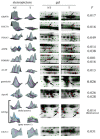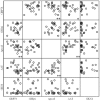Discovery of tumor markers for gastric cancer by proteomics
- PMID: 24404153
- PMCID: PMC3880290
- DOI: 10.1371/journal.pone.0084158
Discovery of tumor markers for gastric cancer by proteomics
Abstract
Gastric cancer (GC) has a high rate of morbidity and mortality among various cancers worldwide. The development of noninvasive diagnostic methods or technologies for tracking the occurrence of GC is urgent, and searching reliable biomarkers is considered.This study intended to directly discover differential biomarkers from GC tissues by two-dimension-differential gel electrophoresis (2D-DIGE), and further validate protein expression by western blotting (WB) and immunohistochemistry (IHC).Pairs of GC tissues (gastric cancer tissues and the adjacent normal tissues) obtained from surgery was investigated for 2D-DIEG.Five proteins wereconfirmed by WB and IHC, including glucose-regulated protein 78 (GRP78), glutathione s-transferase pi (GSTpi), apolipoprotein AI (ApoAI), alpha-1 antitrypsin (A1AT) and gastrokine-1 (GKN-1). Among the results, GRP78, GSTpi and A1ATwere significantlyup-regulated and down-regulated respectively in gastric cancer patients. Moreover, GRP78 and ApoAI were correlated with A1AT for protein expressions.This study presumes these proteins could be candidates of reliable biomarkers for gastric cancer.
Conflict of interest statement
Figures






References
-
- Parkin DM, Bray F, Ferlay J, Pisani P (2005) Global cancer statistics, 2002. CA Cancer J Clin 55: 74–108. - PubMed
-
- Fock KM, Talley N, Moayyedi P, Hunt R, Azuma T, et al. (2008) Asia-Pacific consensus guidelines on gastric cancer prevention. J Gastroenterol Hepatol 23: 351–365. - PubMed
-
- Torpy JM, Lynm C, Glass RM (2010) JAMA patient page. Stomach cancer. JAMA 303: 1771. - PubMed
-
- Ferlay J SH, Bray F, Forman D, Mathers C,Parkin DM. GLOBOCAN 2008 v2.0, Cancer Incidence and Mortality Worldwide: IARC Cancer Base No. 10 [Internet]. Lyon, France: International Agency for Research on Cancer.
-
- Sant M, Capocaccia R, Verdecchia A, Esteve J, Gatta G, et al. (1998) Survival of women with breast cancer in Europe: variation with age, year of diagnosis and country. The EUROCARE Working Group. Int J Cancer 77: 679–683. - PubMed
Publication types
MeSH terms
Substances
LinkOut - more resources
Full Text Sources
Other Literature Sources
Medical
Research Materials
Miscellaneous

